Although it drives me nuts when people serve their red wine straight out of the fridge in the summertime, truth is, most people actually serve their red wine too warm most of the year. And, conversely, most folks serve their white wine too cold.
Last year, Australia’s Wakefield launched a marketing campaign around its Temperature Sensor labels to create public awareness around that very point, that your appreciation of your glass of wine—its flavour, finesse and balance—are often extremely dependent upon the temperature you’re serving it at.
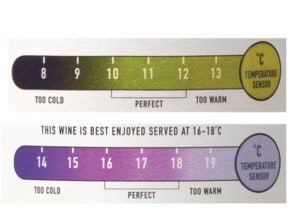
Wakefield’s white wine (top) and red wine (bottom) sensors enable you to enjoy your glass at the ideal temperature.
For example, while the prevailing thinking has been to serve reds at room temperature, that concept has been taken completely out of context, since that “advice originates from medieval French drawing rooms that were closer to a chilly 14˚C – 16˚C,” Wakefield notes. When served at our modern-day room temperature, alcohol and tannins can often overpower a red wine, blocking out secondary flavours.
Serving white wine straight out of the fridge, meanwhile, prevents it from opening up, masking the flavours that are natural to the fruit, as well as tertiary flavours and balance the winemaker sought so hard to achieve during the winemaking process.
The above also helps explain why wine tastes better at the winery that at your dinner table, since they’re typically serving them at optimal temperatures at the winery.
“Our winemakers take great care to craft our wines, so we want to ensure they are experienced just as the winemaker intended,” says Justin Taylor, third-generation family member and Wakefield/Taylors Company Director. “Pop your bottle of red wine in the fridge and experience the difference just a few degrees can make.”
While white wine is best served between 6°C – 12°C, depending on the variety (much warmer than the 3°C – 4°C that the average refrigerator is set at), reds are best served between 12°C – 18°C, depending on the variety (far cooler than the typical Canadian ‘room temperature’), Wakefield explains.
Here’s a simple tip: To get a red wine close to the ideal serving temperature, put it in the fridge for 30 minutes prior to serving, Wakefield’s Chief Winemaker Adam Eggins recommends. As for whites, Eggins suggests taking the wine out of the fridge 20-30 minutes prior to enjoying, as this will give the wine enough time to warm up, opening the wines’ unique aromas and flavours.
But every wine variety has an ideal temperature, which is what makes Wakefield’s technology so cool (if you’ll pardon the pun). Its innovative Temperature Sensor labels are featured on the winery’s Estate and Promised Land wines. Using thermo-chromatic ink technology, these touch-activated sensors change colour depending on the temperature of the wine, so drinkers can see when their wine is at the perfect temperature for drinking.
And while you’re in the wine-drinking mood, here are a couple of wines to keep an eye out for this week. Neither features a high-tech temperature-sensitive label, but now you know a little more about how to best chill with your wine.
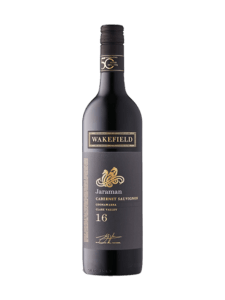 Wakefield Jaraman Cabernet Sauvignon 2016 — Coonawarra/Clare Valley, South Australia ($24.95)
Wakefield Jaraman Cabernet Sauvignon 2016 — Coonawarra/Clare Valley, South Australia ($24.95)
If you ever get into a blind tasting, one of the easier wines to nail—at least as far as guessing where it was grown—might be a Coonawarra Cabernet Sauvignon. There tends to be distinctive minty, eucalyptus notes from this South Australia wine region, and in the case of Wakefield’s Jaraman Cab—although only three-quarters of the grapes were sourced from the Coonawarra—that eucalyptus infusion is notable. It’s accompanied by luscious red and blue fruits (black cherry/raspberry/blackcurrant) and cassis, flowing marble-smooth across the palate. Although medium-plus in body, with an alcohol content that seems much tamer than its listed 14.5%, there’s still a power to this wine. Just remember that its herbal kiss is not shy, so it might not be for everyone. But it is distinctive and I do like a wine having a sense of place. Serve around 16C. 90
 Queenston Mile Red 2017 — Niagara-on-the-Lake, Ontario ($25)
Queenston Mile Red 2017 — Niagara-on-the-Lake, Ontario ($25)
Time and careful blending of this Syrah-dominant blend of five red grapes serve as a reminder that winemaker Rob Power excels in this $20-$25 range (think the exceptional Laura’s Red blend and Iconoclast Syrah from Power’s work at Creekside Estate Winery). Expect delish ripe red fruits and a little earthy character to this midweight-plus wine, with a fairly lengthy finish. Queenston Mile Vineyard has a great online deal going on now for this wine: $99 for six, with free delivery (a savings of $50) 88.5
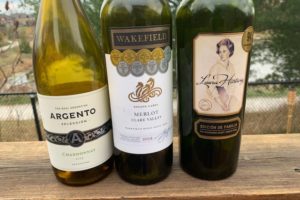

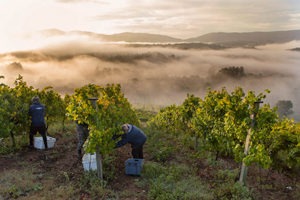
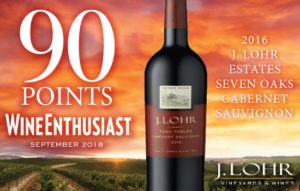
Leave a Reply
Your email is safe with us.